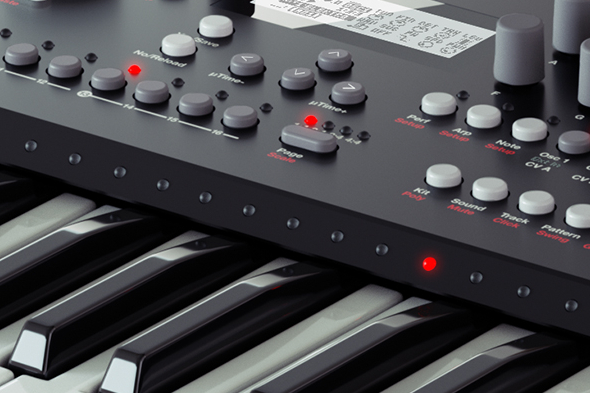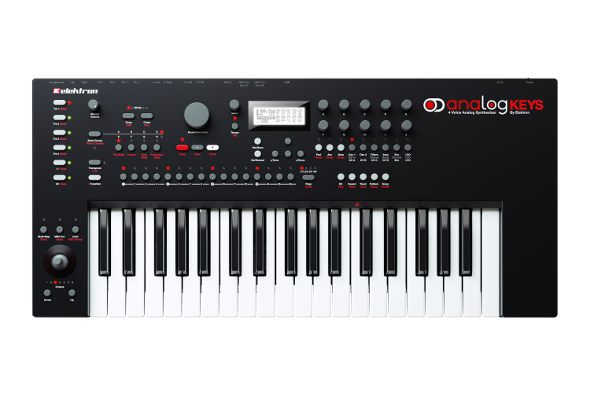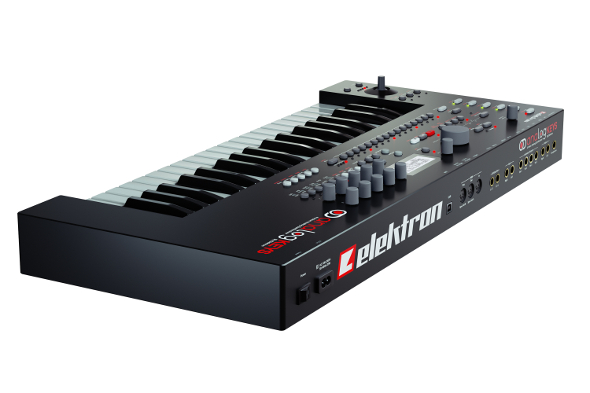Elektron – Analog Four

Rob Lee puts the latest piece of Elektron hardware to the test, a keyboard-equipped version of its popular analogue synth module.
The first thing that strikes you on unboxing the Elektron Analog Keys is the solidity of its frame. It doesn’t feel at all plastic or cheap, and its 37 note velocity sensitive keyboard with after touch is one of the best I’ve come across in terms of player comfort for a long time, which may come as a huge relief to those that have been put off by Elektron’s penchant for small buttons and pads.
The Analog Keys is a synthesizer with two analogue oscillators, as well as two sub oscillators, the pitch of which is controlled digitally with the option of four note polyphony, four note unison for added fatness, or four part multitimbrality, giving you the option of layering different sounds together (this is also available to owners of the Analog Four module via a firmware update). Thrown into this mix is a comprehensive step sequencer that gives you four tracks of synths, a single effects track as well as a track for controlling external instruments via CV/Gate.
As you might imagine, the diverse flexibility of this music-making tool brings the issue of memory storage to the fore, and the Analog Keys doesn’t disappoint in this area, with the capacity for 4096 sounds across its four banks of four configurations. In addition, it gives you the choice of saving 128 projects, with each project being able to cope with 128 patterns and preset kits as well as 16 songs. Further evidence of this machine’s versatility comes when you take a peek around the back and find that not only are there connections for MIDI in, out and through; there are also two sync connections, two CV/Gate ports, a headphone output, main stereo outs, stereo inputs and four separate outs for the four sequencer tracks and USB.

The layout of the unit is such that it has been necessary to implement a menu system to get the most out of all the parameters, which won’t be a surprise to those that are familiar with some of the other Elektron machines. Although the display is rather small, it has been designed to be intuitive to use, and you do find yourself being pointed towards the set of ten push encoders directly to the right of the display. The clearly marked mode buttons allow you to get control of both of the oscillators, two filters, amplitude and envelope and two LFOs. With a wide variety of waveforms and the option to cycle the width of each one (not just the square wave) the synthesis possibilities are wide-ranging.
Each oscillator has its own sub oscillator that can drop one or two octaves as well as a fifth; however, there doesn’t seem to be a clear way of balancing the sub oscillator level, which would have been a nice extra touch. There are two filters configured in series starting with a 24dB four pole ladder filter that has plenty of bottom end even when adding resonance; the second filter is a two pole multimode that can add some real character to your sound by means of different kinds of low pass filter, high pass filters, band pass and band reject. The amplitude shaping is done by a standard ADSR and interestingly the onboard FX sends are in the same menu which is somewhat counter-intuitive.
The filter envelope also gives you ADSR and some interesting shaping options such as the length of the cycle and advanced wave forms. Dual LFOs give you the chance to really give your sound some motion with plenty of routing, speed and depth options. Although the synthesis section is fiddly and you need to get used to jumping around menus instead of having it all in front of you, the end result is that the actual sound of the synth is impressive to the say the least. For those willing to put in the time to learn how to use it, it’s possible to achieve a lot with this one synth.
The star feature however is the four-track step sequencer, which turns this analogue synth into a comprehensive workstation. The mechanics of getting a sequence created is quite frustrating at first, as you have to learn a lot of secondary functions and figure out by trial and error how to enable, mute and record each track, and to this end the quick start guide that comes with the unit does feel inadequate. However, once you have overcome the rather steep learning curve of how the sequencer operates, it is a joyous experience being able to jam your ideas via the step write mode or even by playing them directly in using the record mode.
You might think that four tracks gives you a very narrow set of options to play with, but when you discover the multitimbral mode and the possibility of each step being able to change the patch that the sequence plays, then a world of opportunities opens up. The Analog Keys has three built in sound efects in the form of a chorus, delay and reverb, each of which add a great deal of colour to the resulting patches and sequences you may create. As with most features of this synth, the FX parameters can be fully edited and moulded to fit your design. The fifth track of the sequencer allows you to make step parameter changes on any of the FX you may have assigned and the sixth track lets you get control over any old gear you may have that utilizes CV/Gate technology. The sync connections also allow you to synchronize with other sequencers and drum machines, further widening your performance possibilities.

You would be forgiven for thinking that the Analog Keys is a more performance-focused version of the Analog Four, which also features analog synthesis and the very same workflow in terms of step sequencing. But the Analog Four doesn’t feature the 37 note keyboard or the very handy joystick modulation and pitch control featured on the Analog Keys, both of which make this a serious rival to Dave Smith’s keyboard-equipped Prophet 12, which also offers polyphony, but at a considerably higher price.
Both machines have the USB connectivity for any updates that Elektron offer and with the recent improvement in storage capability, Elektron users have quite a bit more leeway in terms of programming and recall. Elektron are in competition with the recent spate of mini analog units that have come on the market such as the Volca series from Korg or the Aira series coming from Roland. However, the Analog Keys is a single all in one unit, with great sounds and plenty of flexibility.
With devices like the Korg Volca and Roland Aira series aiming to make things simpler for those looking to get into the world of hardware, Elektron’s approach won’t be for everyone. Like all of its devices the Analog Keys takes time to master and at first users might become frustrated at the lack of detail in the instruction manual. A visit to the Elektron website also reveals little in the way of tutorials and help. However, once you have persevered and climbed the rather steep learning curve required to get the most out of this unit, a world of possibilities is opened up to you, not least of which is the opportunity to jam sequences in real time with the added possibility of slotting the unit into an existing hardware set up.
Rob Lee
More info/BuySpecifications:
| Power | 100-250 VAC, 50-60Hz (figure of 8 connection) |
| Polyphony | Four voice |
| Timbrality | Four part multi-timbral |
| Oscillators | 2 x analog oscillators (2 sub oscillators), 1 x noise generator |
| Filters | Four pole analog low pass ladder filter, two pole analogue multi mode filter |
| Effects | Chorus, delay, reverb |
| Sequencing | 4 x synth tracks, 1 x effects track, 1 x CV/Gate track, 6 x arpeggiators, swing, slide, accent, 64 steps per pattern, parameter locks, real time control |
| Memory | 128 projects, 4096 sounds, 128 sounds per project, 128 kits per project, 128 patterns per project, 16 songs per project |
| Keyboard | 37 key velocity sensitive, with aftertouch, joystick X-Y control |
| Inputs | Stereo audio input |
| Outputs | 1 x headphone, 1 x stereo main, 4 x track outputs, 2 x CV/Gate, MIDI I/O/Thru, 2 x Sync, USB |
| Dimensions (cms) | 66x10x31 |
| Weight (kgs) | 5.4 |